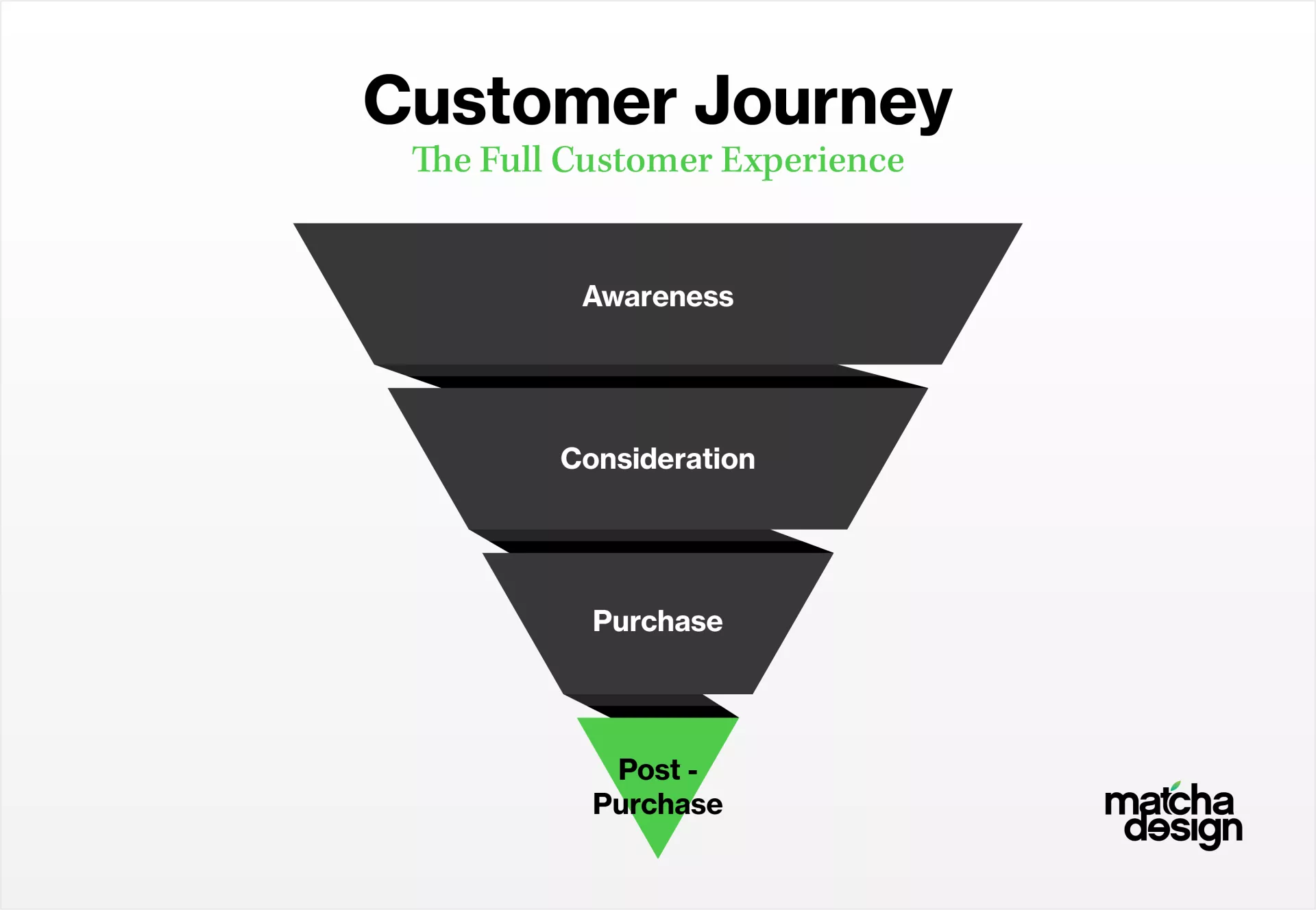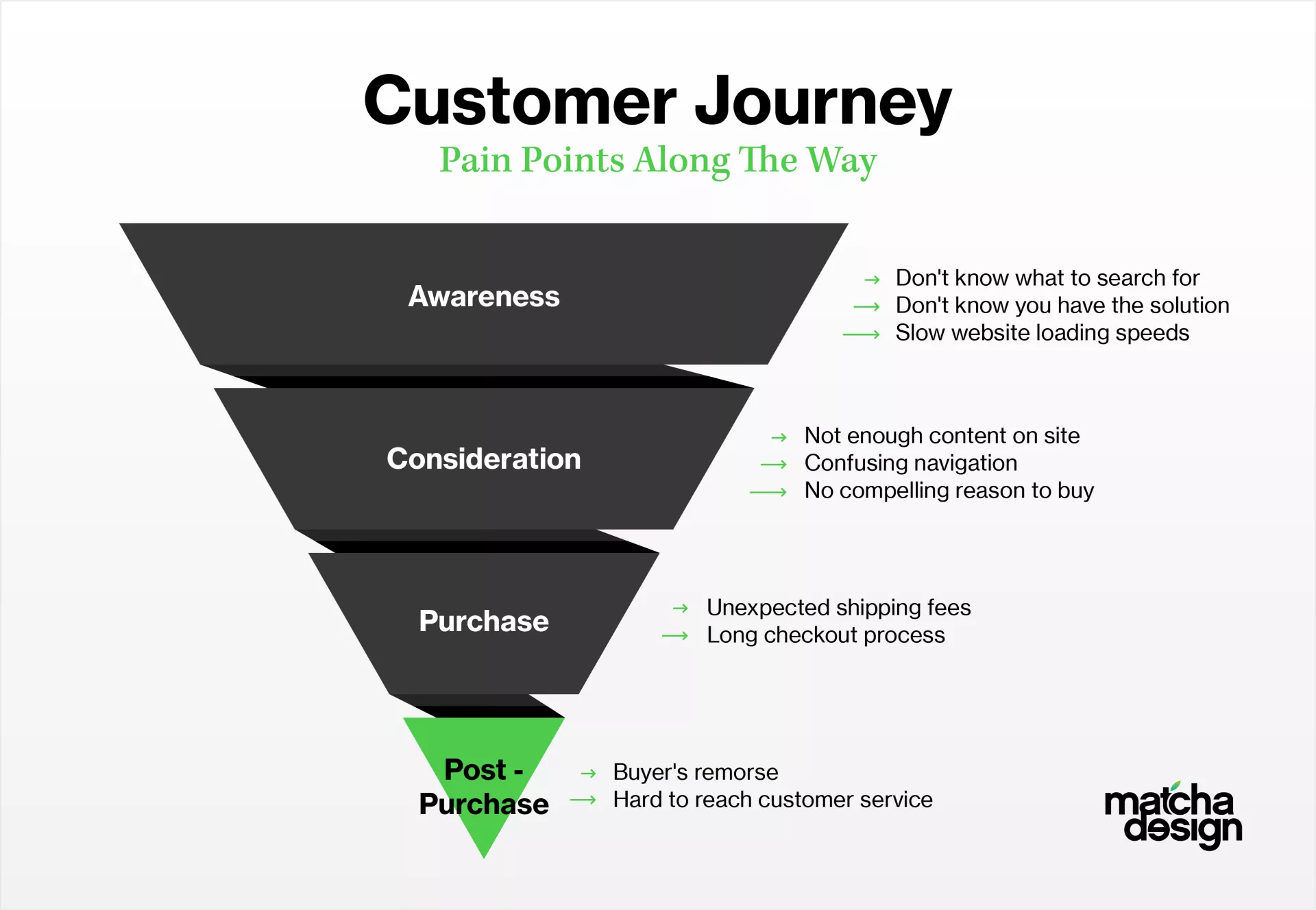Many people don’t think about design and how it affects the customer journey (unless, of course, they’re designers). But design is a major part of creating a seamless customer journey. Without design, you’d be missing out on major elements of the typical customer journey, so let’s explore its importance.
1. What is a Customer Journey?
A customer journey is the full range of actions and experiences that a customer goes through from the time they first learn about the product/service until after they either have a product in-hand or have benefitted from the service.
Why Does a Customer Journey Matter?
Not sure why you should be focusing on a customer journey? Just ask Jay Baer, customer experience expert. He says, “In today’s world, meaningful differences between businesses are rarely rooted in price or product, but instead in customer experience.”
That means that you can set yourself apart from the competition just by providing an amazing customer journey from start to finish… so why wouldn’t you want to do it?
Before you can start, you’ll need an understanding of what a customer journey looks like:
- Awareness. This stage is also called “top of funnel,” or “TOFU,” to marketers. This is the stage where your prospective client first learns about your products or services. They usually reach this stage by doing a Google search, seeing ads, or by word-of-mouth.
- Consideration. This stage is considered “mid-funnel,” or “MOFU.” During this stage, the prospect is learning what they can about your product/service to find out if it’s a good fit for them. The best way to nurture these leads is by providing content like blogs, etc.
- Purchase. This is the stage where the client “pulls the trigger” to make a purchase, and is also considered “bottom of funnel” or “BOFU.” To nurture these leads, you can create a sense of urgency (or nudge them onward with an incentive, like a sale).
- Post-purchase. This step is often overlooked, but it shouldn’t be! Too many clients end up disgruntled because the product did not match up to its claims, or the customer service team was too busy to respond to their needs.
2. Mapping Out the Customer Journey
As you map out the customer journey, one of the most important things to remember is that you’ll need to think about customer pain points all along the way. By ancticipating where the journey gets difficult, you can provide extra help or another push to get them to continue on the path toward becoming loyal customers.
(Even better if you can come up with solutions before they even have a problem!)
You should also think about opportunities to reinforce the overall message you want to convey to the customer. How can you delight them by turning a process that’s usually tedious into something that’s relatively pain-free, or even fun? Something as simple as micro-messaging can make a major impact.
(For example, a coffee brand has this message on the bottom of it’s packaging: “Oh honey, you must be tired. Try the other end.” Little surprises like this can go a long way in helping them warm up to your brand.)
3. UX/UI Design
When it comes to customer service, user-centered is the way to go. By incorporating user-centered design tactics, you can ensure that your product’s design and packaging appeal to the audience you’re marketing to.
Here are some things to consider:
- User research. Find out about your target audience. Learn everything you can: demographics, their preferred way to shop, the type of messaging they prefer, etc.
- Customer personas. Once you have the data, create customer personas around the types of customers you serve the most. The more “real” you can make them, the better!
- User testing. Think you’ve finished once you have a product? Think again: now it’s time for iteration. Get the product in front of people who fit your customer personas to see how they respond to it. Ask them for feedback and offer them something in return.
When you focus on the customer throughout the design process, they will feel heard. Everything about your product or service will scream, “I need this in my life!”
4. Consistent Branding
Whether you’re offering a product or service, consistent branding is a must. If a customer stumbles upon your website while looking for furniture, for example, they’ll be disoriented if the font and brand colors keep changing while they’re navigating your website. It comes off as unprofessional when your branding doesn’t line up with what they’ve gone to expect.
(In fact, they may even wonder if they’re on the right website anymore!)
Having consistent branding, on the flip side, shows that you are professional and an authority that the customer can trust… which means they’ll probably buy that office desk from you instead of the random guy down the street with a confusing online presence.
5. Web Design
But what if you don’t have an online presence at all? Or what if you’re only on Facebook Groups? We hate to tell you this, but you’ve got to have ownership of your own little piece of the internet.
Many companies make the mistake of thinking that showing up on Facebook or LinkedIn will work fine, only to be hacked or banned for no reason by the platform. Then what happens to all those leads and your customer base?
The best way to use any forms of social media are to use them as a landing page to direct customers to your website. If you get people to sign up for your newsletter or find other ways to generate traffic to your website, you will win.
Now that you know why it’s important to have a website, let’s talk about how to create a phenomenal web design that customers want to come back to:
- Navigation. Some things you can add for better navigation: internal search, a footer with links, hyperlinked logo, and web navigation for mobile.
- Layout. The layout should be simple and logical, thoughtfully and meaningfully developed (preferably by professionals).
- Responsive design. Every modern website should have a responsive design, so it’ll work the same way whether the customer is on their phone, a tablet, or desktop.
6. Optimize for Mobile
Over half (55%) of website traffic comes from mobile, and 92.3% of internet users access the internet using a mobile device. This means that if you don’t focus on optimizing for mobile, you’ll be missing out on over half the website traffic you could be getting. In addition to using responsive design, you should also add a mobile-friendly interface and other mobile-specific features, like testing it for mobile.
7. Visual Storytelling
Visual storytelling can heighten the emotional experience of the purchase and enable your customer to form a connection with your company. Through the use of visuals, graphics, and multimedia content, you can reinforce your brand values and show the smiling faces of the people behind your brand.
8. Customization and Personalization
We touched on the importance of a personalized experience a bit in the “Customer Journey” portion, but we’ll go more in-depth now. Adding dynamic elements to your website that enable you to give customized recommendations to your customers based on things they’ve already purchased can be a huge plus, streamlining their shopping experience with you and making them feel like more than “just another customer” in your mind.
Giving them an opportunity to create tailored user interfaces is another way to add an element of personalization to your website. Do you enable them to change the layout to their favorite colors? Do you offer a “dark mode” for those who might be scrolling at night? Offering these things can help you get a leg up on your competition.
9. The Experience After Purchase
When was the last time you sent a “thank you” email to one of your loyal customers? Have you ever offered a discount or even taken the time to write a personalized “thank you” for their patronage?
Most companies don’t think to focus on the after-purchase experience, but it can make a major difference in the way a customer feels about your product or service. If you sell a product, consider creating a thoughtful packaging design that will appeal to your customers. (Most customers are eco-friendly. Creating packaging that is either made of recycled materials, is recyclable, or both, is a good way to satisfy earth-conscious customers).
If you provide a service, a quick thank-you email or other type of follow up communication (even if it’s to say, “Hey, here’s our customer service number/email if you have any questions!”) can be a great way to reinforce your gratitude for their business.
Think of ways you can serve your customers and let them know you’re grateful, and you’ll get customers with a positive impression of your brand.
10. Measuring and Analyzing Success
Once you’ve got all of the pieces in place, you can measure the success of your design efforts. When it comes to web or app design, the metrics are fairly straightforward: conversion rate, bounce rate, web traffic, task completion rate, returning visitors, etc.
But if you’re designing something else – product packaging, for example – it can be a bit trickier.
In those cases, it’s smart to collect user feedback about the elements you’ve designed. Sit down with some potential clients and current ones to see what they liked and didn’t like. A mastermind session with customers and stakeholders could also go a long way in determining the success of the project!
Learn More from Matcha Design
“Design” is a broad term that encompasses everything from physical print and packaging design to digital assets like websites and apps. Because design is part of every customer touchpoint, it could feel very overwhelming to be responsible for it all.
We’ve got good news: that’s what we’re here for! At Matcha Design, we’ve got decades of experience designing a wide range of projects, and we’d love to help you with yours. Get in touch today to see how easy it is to work with us.






